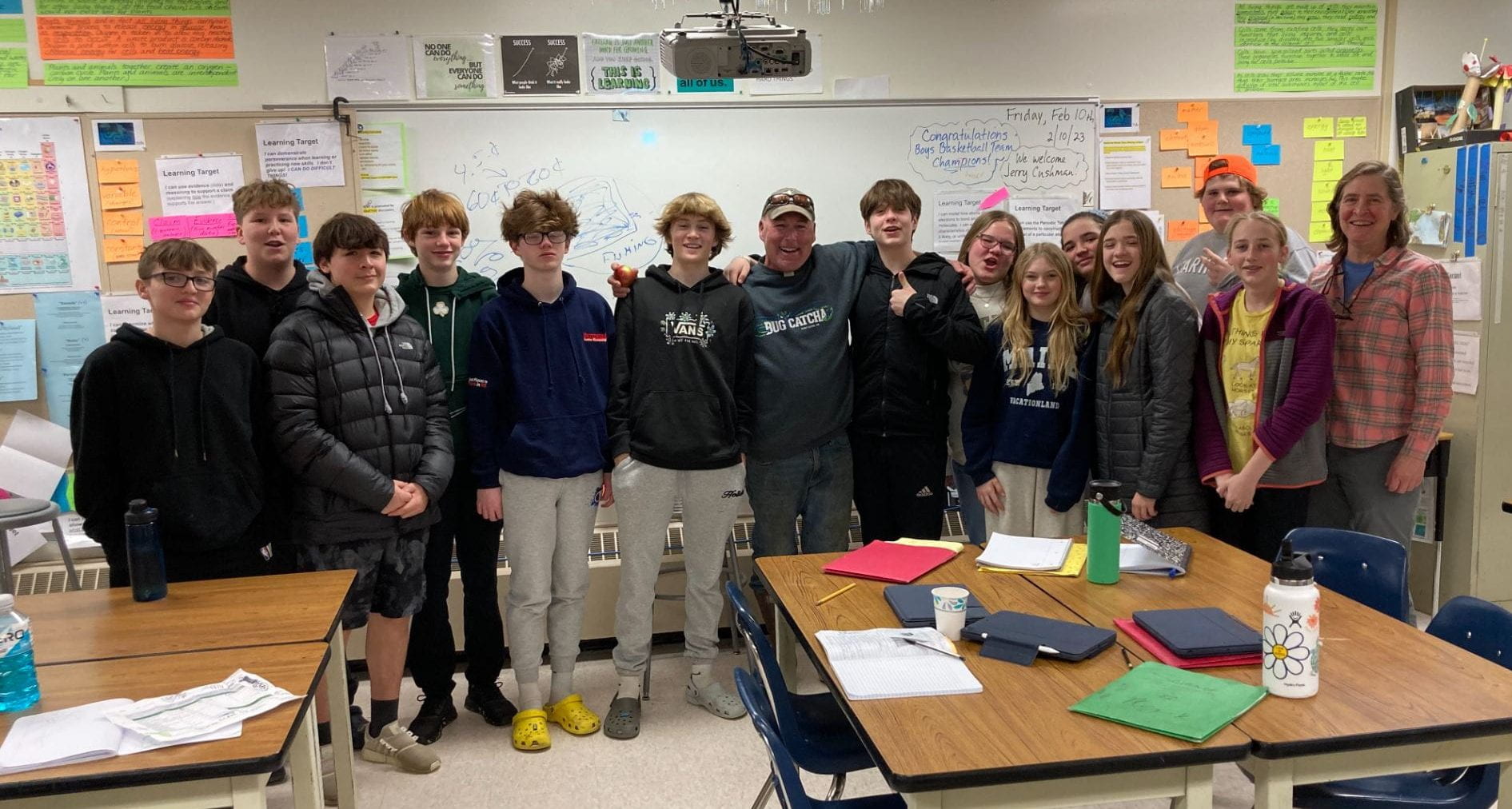
An Invitation
We asked Mr. Cushman to speak to our class, thinking of the recent flooding of the Co-Op and wondering about his experiences fishing for many years and how he observes changes that are happening because of climate change. The following is a re-telling of the information he shared with the class.
The Port Clyde Co-Op
Gerry Cushman is a 7th generation, Port Clyde fisherman. The Co-Op was founded by 14 fishermen, 7 of whom were Cushmans, and started with rented property in the 1960’s. The fishermen were concerned about having continued access to the working waterfront and being able to command a better price for their lobsters. How the Co-Op works is that the members use the property while they fish, and when they retire from fishing, it is passed on to the next generation. You don’t have to be a family member to join. Today, a share of the Co-Op is $5,800. When the Co-Op was formed, they didn’t worry about flooding, or climate change.
The Co-op provided fishermen with access to the water along the sardine factory site (Factory Hill) and where Linda Bean’s wharf is. Then, the property that is the Co-Op today, which is opposite the Port Clyde Post Office, was purchased for $160,000 in the 1980’s. The dock and the property needed a lot of work, and the members continued to make improvements. When hurricane Katrina hit New Orleans in 2005 and caused devastating flooding federal legislation was passed and where properties in flood zones had mortgages, they now required flood insurance. The Co-Op’s flood insurance cost $42,000 each year. Plans were made to pay off the mortgage by raising the cost of individual shares so that the flood insurance could be dropped .
After the mortgage was paid off, the Co-Op applied and received nearly half of million dollars of grant money ($460K) and built a brand new dock in 2008, which they opened to the public. At this time, the wiring and hydraulics of the buildings were raised four feet, with future flooding in mind. The December flooding (Dec. 23, 2022) was about two feet and because of the foresight of elevating the wiring and hydraulics, thousands of dollars of damage has been avoided. However, there is undermining happening, and with recent underwater cameras to survey the condition of the property, there are holes underneath the bait shed.
Changing Fisheries
Mr. Cushman commented how change over the years had been happening at a relatively slow pace, but has since accelerated, and today he feels that things are now changing even faster.
When he was a kid (he’s 52 years old), ground fishing was “king”. There were 28 different boats from Port Clyde ground fishing. Now there are two: Randy Cushman and Buzz Libby. Shrimping was one of his favorite times of the year in Port Clyde. He described the activity as “its own city in the winter”. Peddler trucks would arrive and buy trays of shrimp to sell on the sides of the road somewhere else in Maine as well as out of state. Two to three million pounds of shrimp were caught by Port Clyde boats and at a dollar a pound, that was two to three million dollars in our community. Scalloping used to be a big fishery here too. Although its coming back, for twenty-five to thirty years it had been in decline from disease and “gray meat”. Urchins were another local fishery. Over a million pounds of urchins were landed here. Today, our fisheries are all in “one basket”; lobstering.
To share some immediate concerns about the future of lobster, he mentioned regulations to protect the Right Whales. To rig a trap for rope-less fishing costs $800 a line. This year, a six year pause in the requirement for rope-less traps has been passed by the US Congress because of lobbying by well-educated lobstermen. Gerry made a point to advocate for all to get a good education; to learn how to speak and to learn how legislation is passed because lobbying for the fishing industry is something he has had to do for nearly 30 years. He has travelled to Washington, D.C. and is personally known by Maine’s Senators. He also made a point to say that bullying and being rude is not a way to bring about change. You will get more accomplished in the long run by being respectful, not by bullying.
He explained fishermen’s concerns about offshore wind plans. The best fishing grounds are also the areas where the best locations for wind power. The size of our gym is about the size of a platform for one turbine. If that turbine were located in 100 fathoms, then the anchor chains, which would come from each of the four corners of the platform would need to extend three times that depth, or from about here (at school) to Wildcat. Each chain link is the size of a Volkswagen. Despite claims that fishing can occur around the platforms, he states that wind power companies and the companies that insure them would not allow fishing in those areas.
Thinking back to the fishing history of Port Clyde, he described that the past 30 years were “like Tom Brady’s playbook”. You could just follow the playbook. The fisheries were constant and every year was like the previous year. Now, there are shedders (soft-shell lobsters) year round (instead of only in the warmer months.) Lobsters are about the only fishery that has shown amazing growth. When Mr. Cushman started lobstering, perhaps 40-50 million pounds were landed in the state. Today, 100 million pounds are landed in Maine! However, more lobsters are moving offshore. Twenty years ago, maybe 40% of the catch was offshore, and 60% from inshore. Today it’s flipped; 40% are caught inshore and 60% offshore. To catch offshore there are more winds and fuel costs.
When asked if he could imagine new fisheries emerging in the future, he spoke how pogies are now an important fishery, how the scallops are coming back and that Stellwagen Bank can be fished by Mainers, and how black sea bass are now being caught in Portland. In the future, perhaps black sea bass may become a fishery. He said how opportunity is out there. He mentioned how all these resources are controlled by quotas and from time to time, the Maine Coast Fisherman’s Association (founded by Port Clyde fishermen in 2006) buys quota so that the opportunity for future fishing of those species is preserved. He emphatically stated that the resource is the most important thing. You have to protect the resource and the resource needs to be put first. He went on to make the point that maybe these students could lobster today, but to be educated and do something else as well and perhaps do lobstering on the side, in case it won’t be there in the future.
When asked about the conservation of alewives and their successful runs providing a source of spring bait, Gerry lit up and said how alewives were his favorite bait, and how springtime was his favorite time of year. He described spring and return of alewives as “bringing life”, since so many birds and animals depend on the fish. He told us how the alewives were a wiped out fisheries until dams were removed and the harvests regulated to allow fish to breed. At its worst, he would wait seven days for as few as three trays of bait. He stated the alewives have experienced a “fantastic recovery” and are a great story.
He reminisced that he went to school where the town offices are now. At Christmas break, they had just finished building our school (our current building) and when they came back from vacation, they were the first students to be in our school that we have now. He remembered how the Shop and Home Ec classes were in the buildings along the shore (past the town office) and when the alewives arrived that spring, Mr. Philbrook, the shop teacher and Mrs. Garrett, the Home Ec teacher allowed kids outside to see and watch. He said that was the first time he really had any awareness of the alewives. Mr. Cushman remembers watching the fish move up Ripley Creek with a wake behind them, just like a boat’s wake, and how the fish flipped themselves into the marsh and all the osprey and seagulls followed making it that much more exciting.
As our time ended, we gathered around him for a picture; with much to think about and grateful for his time and caring to help teach this next generation about their heritage and both the opportunity and the challenges for Port Clyde fisheries in the future. Thank you, Mr. Cushman!
STUDENT REFLECTIONS
A main theme he focused on was how the local fisherman have overcome the past challenges they have faced. From finding a way to pay off their mortgage, to finding a way to prevent major flood damage. I believe the Cushmans and other big families in the area have helped our community greatly and we might not have such a successful fishing community like we now if it weren’t for all the families’ hard work.
I would ask him what would be the one thing you want to pass down to younger generations?
He…talked about the future of his hometown and the effects of flooding. I learned that the Co-Op is built to withstand flooding by raising the buildings and making sure electronics were out of the way of flooding. I also learned that there were many different types of fishing happening in Port Clyde in the past. Now there are only a couple like lobstering and scalloping. Another thing that surprised me was that lobstering is going downhill and lobstering is one of the main sources keeping Port Clyde alive.
Would you have chosen lobstering as your first job if you knew it would turn out like this?
He really emphasized the differences between today and when he was a kid…how the business has changed.
I didn’t realize that the government had so much control over fishing communities. Sure they don’t have complete reign but they can tell fishermen to use rope-less traps. I knew alewives were an important part of our town’s history but it is really amazing to hear the stories of kids going down to the marsh to watch the run. I was surprised by how many other fish and shellfish species used to be caught on our peninsula. Now it’s mainly lobsters that are caught mostly because other creatures have moved to colder waters. Soon lobster will follow. Things need to change in order for the fishing community to survive.
It was surprising to think about how big a part fishing really is for our community and that without it the community might not even be around…sea level rise is an important topic we need to address it and that it really does effect our community in different ways.





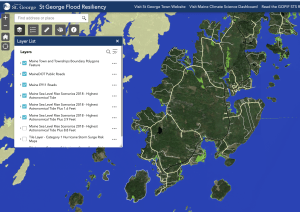

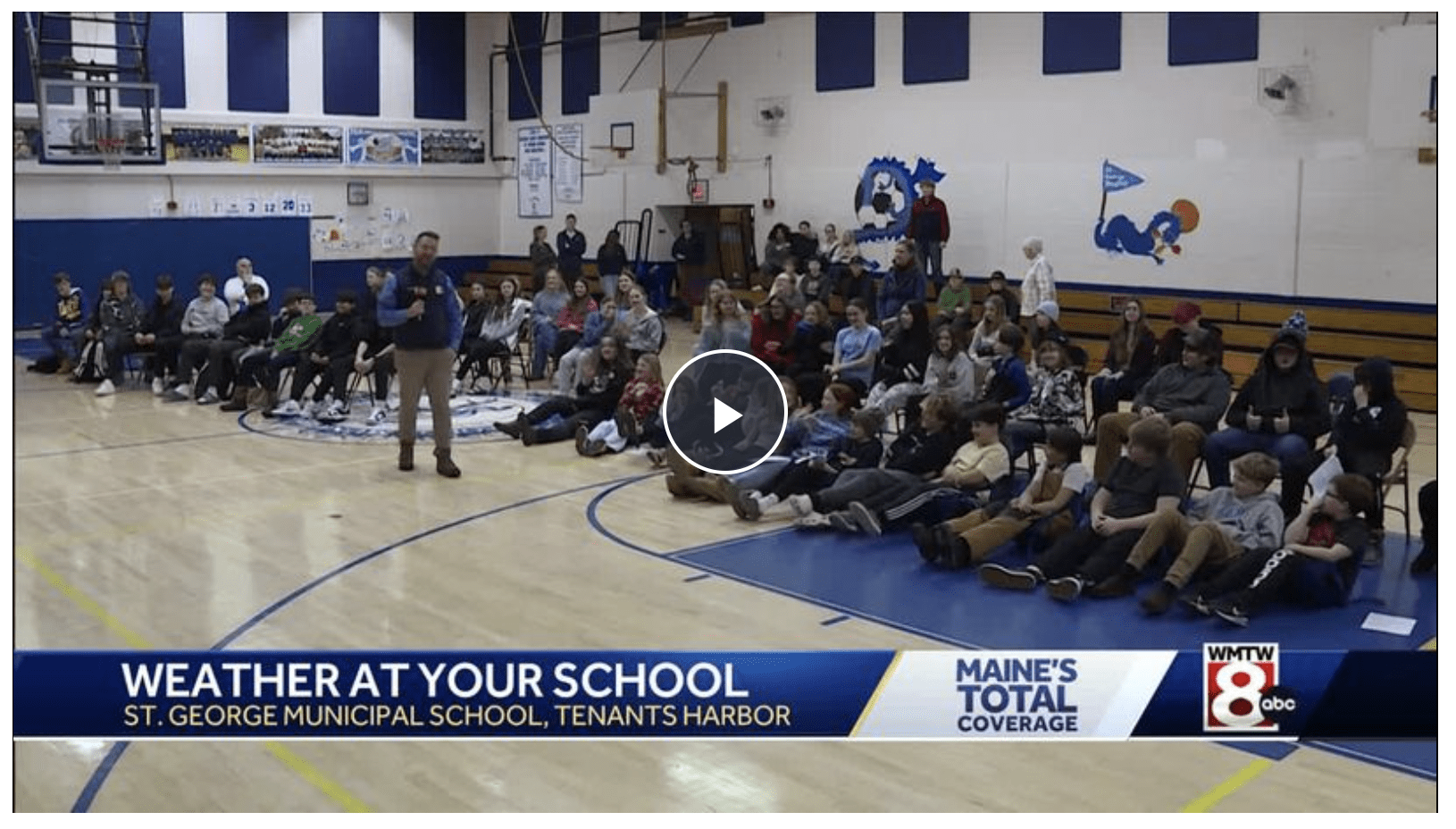
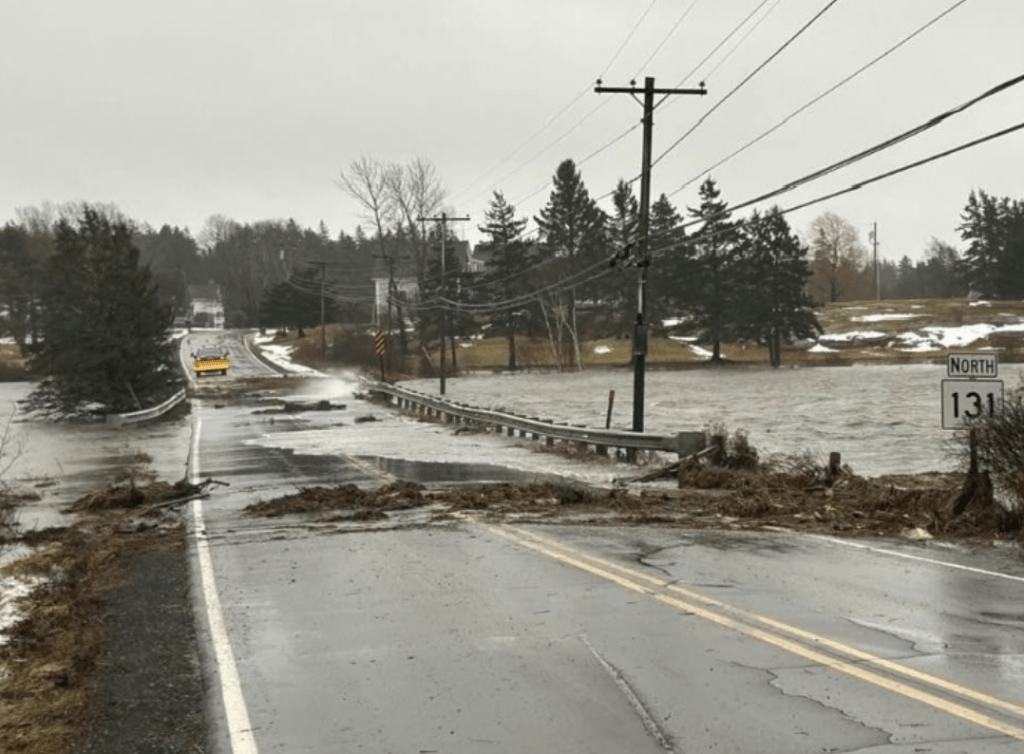



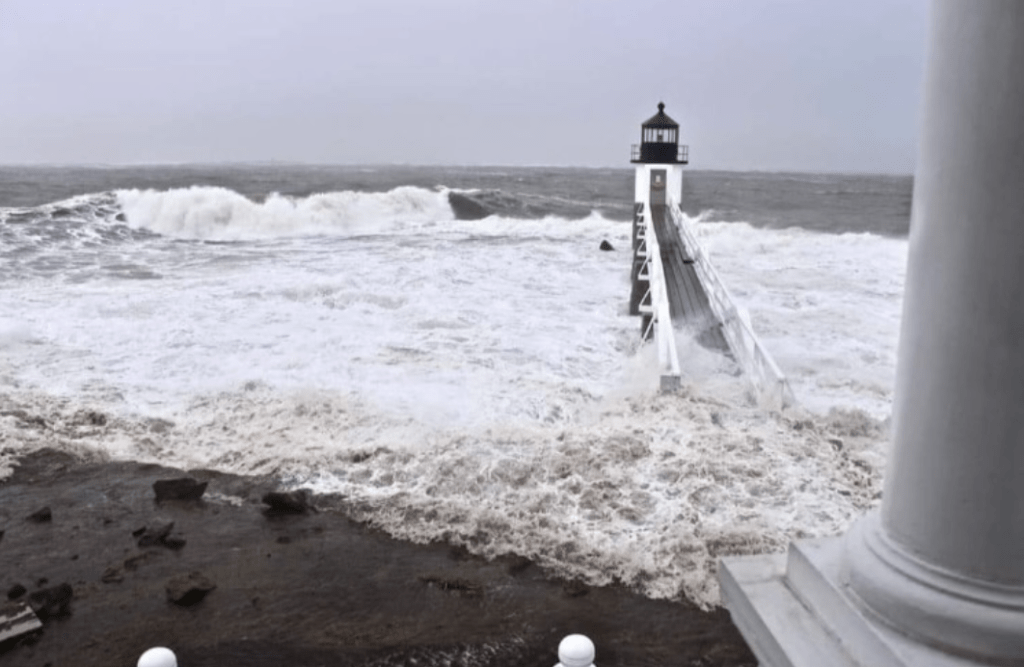 Portlands measurements of peak winds and record storm surge events
Portlands measurements of peak winds and record storm surge events
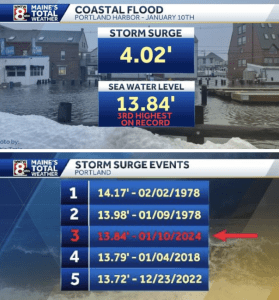


 On November 6th, the 8th Grade class was invited by Gulf of Maine Research Institute (GMRI) to meet in Port Clyde at the site of the relocated tide gauge that is an important part of our town’s planning for sea level rise resiliency for an introduction to the community sea level rise work that is going on.
On November 6th, the 8th Grade class was invited by Gulf of Maine Research Institute (GMRI) to meet in Port Clyde at the site of the relocated tide gauge that is an important part of our town’s planning for sea level rise resiliency for an introduction to the community sea level rise work that is going on.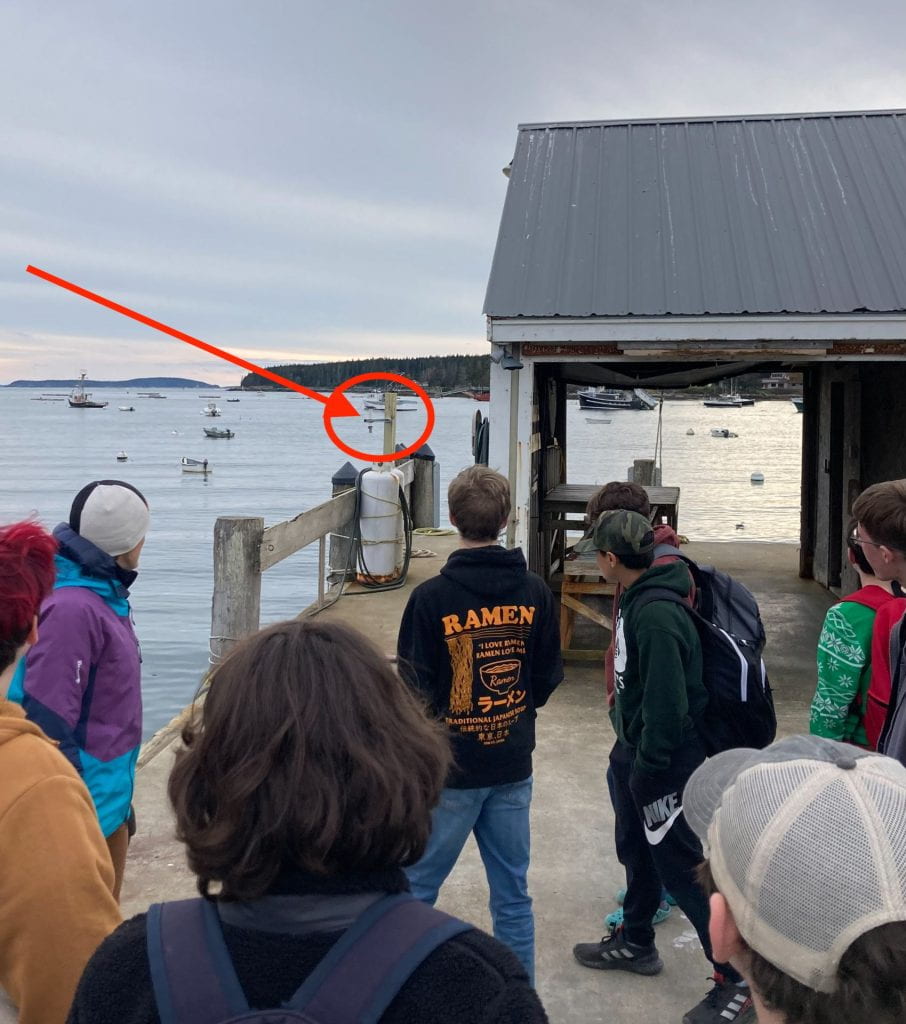 One of GMRI’s lead Climate Center scientists, Dr. Hannah Baranes, spoke to students about the town’s effort to collect tide data and introduced students to three other colleagues with her that day who worked together to install the gauge. They explained how the gauge uses ultrasound to sense the height of the water below the unit mounted on the side of the pier, and how their GPS staff “talked” to satellites to help establish the elevation of the gauge in its physical location and geographic surroundings to determine tide measurements.
One of GMRI’s lead Climate Center scientists, Dr. Hannah Baranes, spoke to students about the town’s effort to collect tide data and introduced students to three other colleagues with her that day who worked together to install the gauge. They explained how the gauge uses ultrasound to sense the height of the water below the unit mounted on the side of the pier, and how their GPS staff “talked” to satellites to help establish the elevation of the gauge in its physical location and geographic surroundings to determine tide measurements.



 Later this winter, students will be involved in observations that the town is interested in gathering from citizens that provide water level descriptions of vulnerable or impacted sights. These observations can now be paired with accurate data from the tide gauge to define specific impacts as well as help inform how local tidal changes are unfolding along our shores.
Later this winter, students will be involved in observations that the town is interested in gathering from citizens that provide water level descriptions of vulnerable or impacted sights. These observations can now be paired with accurate data from the tide gauge to define specific impacts as well as help inform how local tidal changes are unfolding along our shores.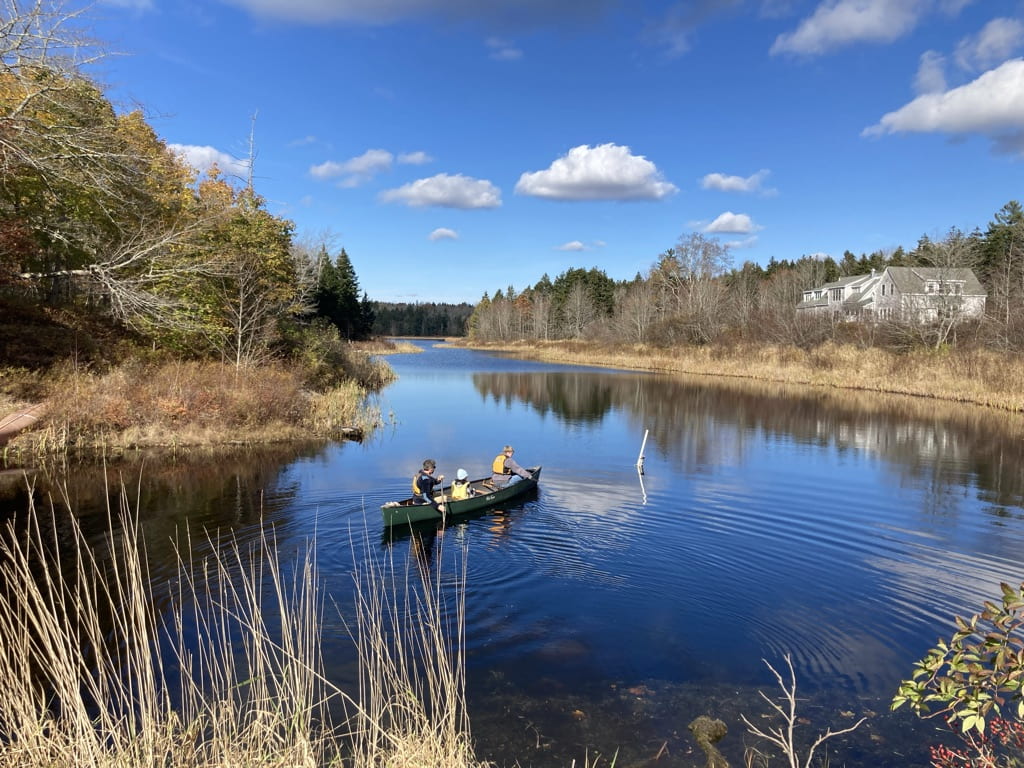

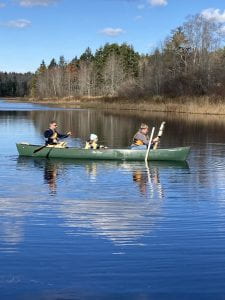
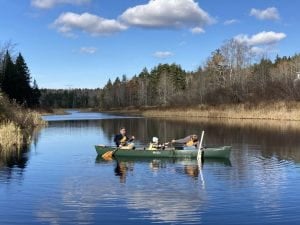





 Nadia and Nora had the honors to put in the post and mount the probe on the post via the canoe with Mr. Meinersmann while their classmates looked on.
Nadia and Nora had the honors to put in the post and mount the probe on the post via the canoe with Mr. Meinersmann while their classmates looked on.

 Here’s how we sampled. We began by getting a control sample. It’s purpose is to make sure that our results are from DNA in the water, and NOT from DNA in the air or DNA introduced from people.
Here’s how we sampled. We began by getting a control sample. It’s purpose is to make sure that our results are from DNA in the water, and NOT from DNA in the air or DNA introduced from people. We did this by holding a mini water bottle of pure water in the air to capture any DNA that might be in the air. This was then poured into a sterile Nalgene bottle and sealed. We had to be super careful not to contaminate anything, so we wore gloves and couldn’t touch anything once we had our gloves on.
We did this by holding a mini water bottle of pure water in the air to capture any DNA that might be in the air. This was then poured into a sterile Nalgene bottle and sealed. We had to be super careful not to contaminate anything, so we wore gloves and couldn’t touch anything once we had our gloves on. We all took turns filtering the whole bottle, then Ms. Campbell took the glass capsule with the filter off the syringe, bagged it, and put it on ice for the car ride back to the University. Although we only had time to filter our control sample, the other two bottles with marsh water were filtered at the University.
We all took turns filtering the whole bottle, then Ms. Campbell took the glass capsule with the filter off the syringe, bagged it, and put it on ice for the car ride back to the University. Although we only had time to filter our control sample, the other two bottles with marsh water were filtered at the University.

 We’d like to give a special shout-out to Ms. Palmer who made this opportunity possible.
We’d like to give a special shout-out to Ms. Palmer who made this opportunity possible. 







 We “zoomed” with UMaine PhD candidate Sharon Mann who shared a presentation about the “Maine-eDNA” program (‘eDNA’ referring to environmental DNA), a cooperative state-wide initiative that applies genetic technology as an information tool for resource managers. These state managers may be working to protect threatened or endangered species, like the sturgeon or Arctic char, or to fight invasive species in freshwater ponds/lakes that disrupt the local ecosystem. Sharon Mann’s own research involves learning about the water quality impacts of alewife restoration in freshwater systems.
We “zoomed” with UMaine PhD candidate Sharon Mann who shared a presentation about the “Maine-eDNA” program (‘eDNA’ referring to environmental DNA), a cooperative state-wide initiative that applies genetic technology as an information tool for resource managers. These state managers may be working to protect threatened or endangered species, like the sturgeon or Arctic char, or to fight invasive species in freshwater ponds/lakes that disrupt the local ecosystem. Sharon Mann’s own research involves learning about the water quality impacts of alewife restoration in freshwater systems.